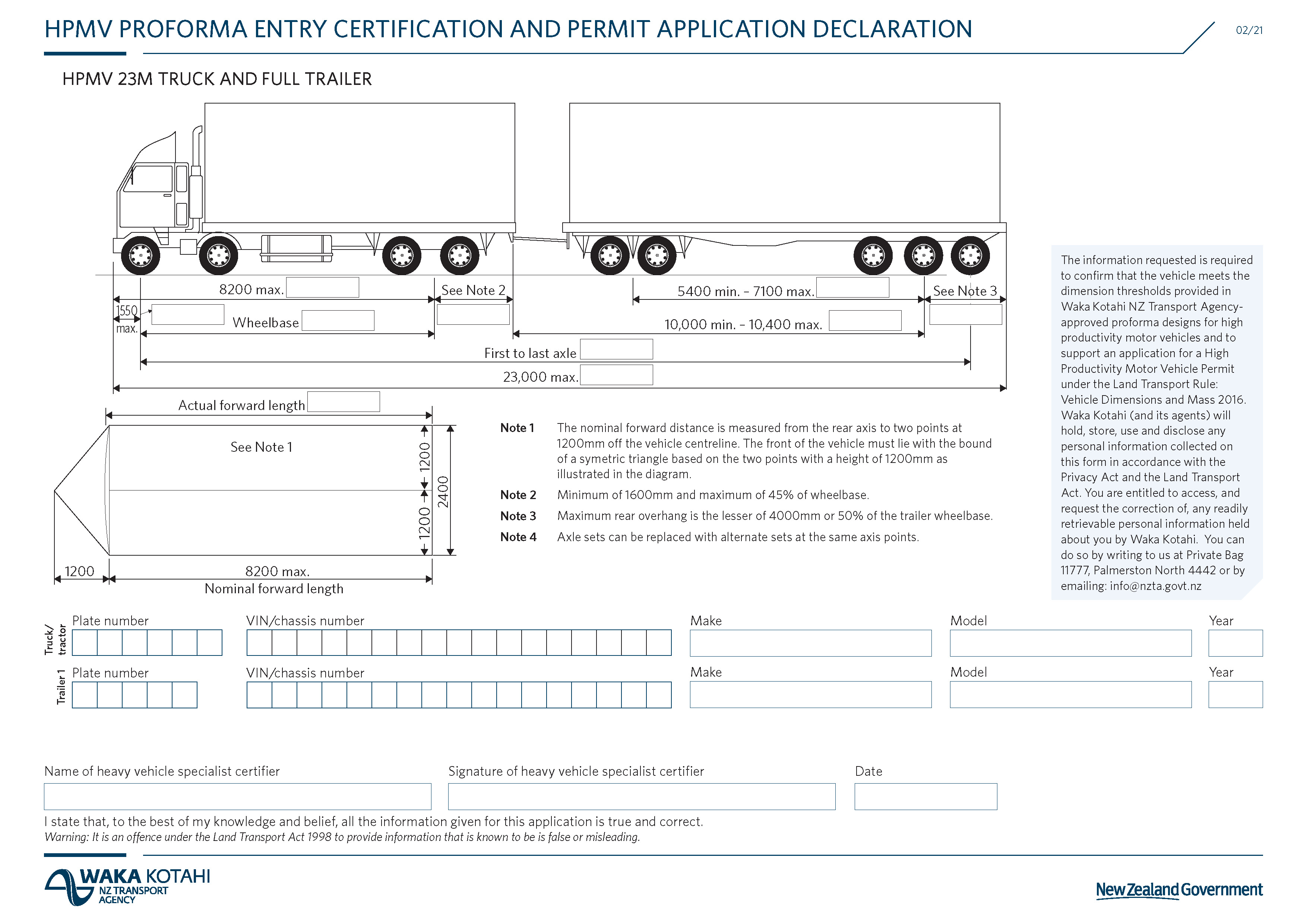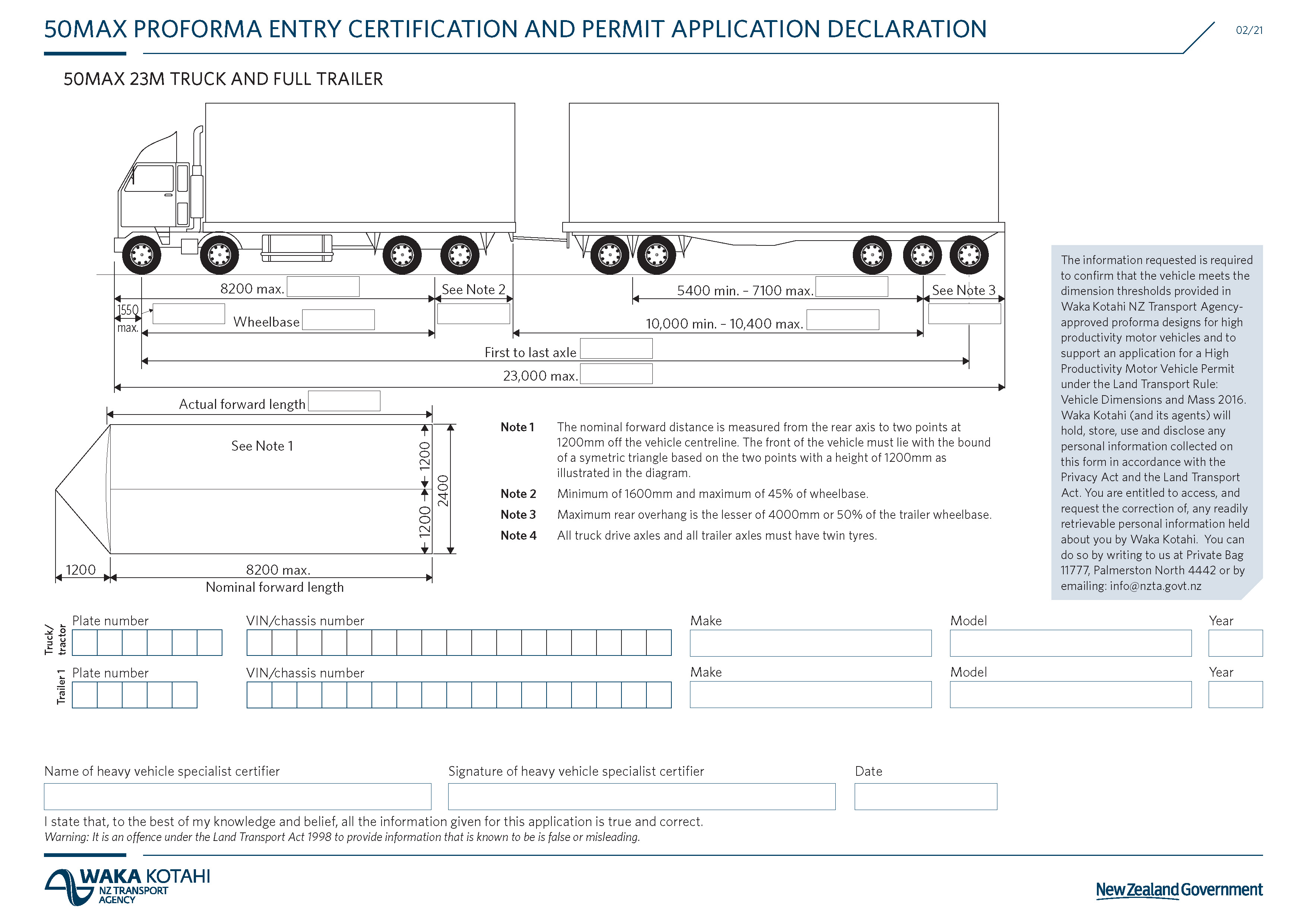Vehicle exterior
2-2 Dimensions
The vehicle inspector need only inspect dimensions in detail if there is doubt about the vehicle’s compliance. |
Reasons for rejection
Mandatory equipment
1. A rigid vehicle (Note 1) with a GVM of 3501kg or more exceeds the dimension requirements set out in Table 2-2-3 and is not:
a) a specialist overdimension vehicle (Note 2), or
b) a vehicle designed primarily to transport an overdimension load, or
c) a vehicle operating on a valid permit, exemption or approval, or
d) a vehicle presented with a completed 50MAX proforma entry certification and permit application declaration or HPMV proforma entry certification and permit application declaration signed by a heavy vehicle specialist certifier (Note 8) (Figure 2-2-5).
2. A rigid vehicle that exceeds the dimensions set out in Table 2-2-3 is not fitted with the appropriate hazard warning equipment set out in Table 2-2-4.
3. A required beacon cannot be activated and deactivated.
Note 1
Rigid vehicle means a vehicle with motive power, driver’s position and steering system, that does not have any pivot points to allow any part of the chassis of the vehicle to move or rotate in relation to any other part of the chassis of the vehicle; but includes a pivot steer vehicle.
Note 2
Specialist overdimension vehicle means a vehicle of which the primary purpose is to carry out a specialist function that requires overdimension equipment, and is not primarily designed to transport overdimension or overweight loads and the dismantling of the equipment would make it unusable for its intended purpose, or it would take more than four hours to dismantle the equipment. Additional operational requirements may apply, eg if operated at night.
Note 3
High-productivity motor vehicle (HPMV) means a heavy motor vehicle or heavy combination vehicle with or without a load:
a) exceeds a gross mass of 44,000kg, or
b) varies from a dimension requirement in Table 2-2-3, (other than width, height or ground clearance), or
c) both (a) and (b), and
d) operates on an HPMV permit issued by a road controlling authority.
Road controlling authority means the authority, body or person having control of the road (eg the Transport Agency, regional council or an authorized delegate)..
Note 4
An HPMV that does not comply with a dimension requirement in Table 2-2-3 may comply instead with a variation to that requirement as specified on the HPMV permit. The permit must be produced for inspection if required. Any other conditions specified on the permit are not required to be enforced at CoF.
Note 5
A bicycle rack fitted to the front of a vehicle of class MD3, MD4 or ME is not included in determining the overall length or forward distance of the vehicle provided the vehicle complies with the applicable swept path performance measures in section 3.5(2) of the Land Transport Rule: Vehicle Dimensions and Mass 2016.
Note 6
A high-productivity motor vehicle is not required to comply with the Hazard warning equipment requirements of Table 2-2-4.
Note 7
Instead of displaying a hazard warning flag or panel, the boom head of a mobile crane may be painted to delineate its excess front overhang, provided that the colour of the paint on the front face of the boom head is either white, yellow or red or a combination of these colours, so that the area on each side of the boom head that is painted covers an area of not less than 0.12 square metres (eg 400mm x 300 mm).
Note 8
The entry certification and permit application declaration forms can be downloaded from the Waka Kotahi website:
50MAX proforma entry certification and permit application declaration
HPMV proforma entry certification and permit application declaration
Table 2-2-3. Dimension requirements for heavy rigid vehicles
(see Note 4, Note 5)
Dimension | Maximum distance | Comments |
|---|---|---|
Width | 2.55m, or 1.275m from each side of the longitudinal centreline of the vehicle | Measurement does not include:
|
Overall length | 11.5m (tow coupling fitted) 12.6m (no tow coupling fitted) 13.5m (rigid bus with three axles where the rearmost axle is a single-tyred steering axle that is: a) either positively and continuously linked to the front steer (except may be locked for reverse and high-speed operation); or b) automatically locked at a speed of 30 km/h in the straight-ahead position and for reverse operations) 18m (articulated bus) | Measurement does not include:
|
Height | 4.3m | |
Forward distance | 8.5m (tow coupling fitted) 9.5m (no tow coupling fitted) 8.5m (for both front and rear sections of an articulated bus) | Forward distance is measured from:
Measurement does not include collapsible mirrors. A vehicle with a retractable axle must meet the dimension requirements whether the axle is in contact with the road or in the retracted position. |
Rear overhang | 4m or 70% of wheelbase (whichever is less) wheelbase where rearmost axle is a non-steering axle 4.25m or 70% of wheelbase (whichever is less) wheelbase where rearmost axle is a steering axle 4.5m or 72% of wheelbase (whichever is less) of a rigid bus that exceeds 12.6 in overall length 4m or 50% of forward distance (whichever is less) of an articulated bus 4m (for a vehicle first registered anywhere before 1 December 1989) | Rear overhang is measured from the rear axis to the rear of the vehicle. A vehicle with a retractable axle must meet the dimension requirements whether the axle is in contact with the road or in the retracted position. |
Ground clearance | The greater of 100mm or 6% of the distance from the nearest axle to the point where the ground clearance is measured | Measurement does not include flexible mudflaps, wheels, tyres or devices designed to discharge static electricity. |
Front overhang | 3m | Front overhang is measured from the front edge of the driver’s seat in the rearmost position to the front of the vehicle. |
Articulated vehicle point of attachment | No further rearward than centre of rear axle (where rear axle set consists of only one axle) No further than 300mm rearward of rear axis (where rear axle set consists of more than one axle) | Does not apply to articulated buses. |
Tow coupling position (articulated bus only) | 45% of wheelbase of the leading unit | The tow coupling position is the distance rearward from the vehicle’s rear axis to the centre of the tow coupling. |
Turning circle | 25m outside diameter 10.6m inside diameter (articulated bus only) | The vehicle must complete a 360-degree turn in either direction. No part of the vehicle (other than collapsible mirrors) must extend beyond the outside diameter or into the inside diameter. |
Table 2-2-4. Hazard warning equipment requirements for vehicles that exceed the dimensions in Table 2-2-3 (see Figure 2-2-3 for vehicle category thresholds) (Note 6)
Vehicle category | Dimension | Limits | Required hazard warning equipment |
|---|---|---|---|
Category 1 | Width/forward distance | 2.55m /11.4m, or 3.1m/10.5m, or 3.7m/8.5m, or |
1. Flags1 or panels2 fitted on each side at the front and rear as close as practical to the outside edge (for alternative requirements for a mobile crane see (Note 7)) 2. OVERSIZE sign3 fitted at the front and rear if more than 3.1m wide |
| Length | 25m, or | ||
| Front overhang | 7m, or | ||
| Rear overhang | 7m | ||
Category 2 (not including category 1) | Width/forward distance | 2.55m /13.3m, or 4.5m/8.5m, or |
1. Panels2 fitted on each side at the front and rear as close as practical to the outside edge (for alternative requirements for a mobile crane see (Note 7))
2. OVERSIZE sign3 fitted at the front and rear if more than 3.1m wide 3. Amber beacon fitted so that it is visible to approaching traffic if the vehicle is more than 3.7m wide |
| Length | 35m, or | ||
| Front overhang | 10m, or | ||
| Rear overhang | 10m | ||
Category 3 (not including category 2) | Width/forward distance | 2.55m /20m 5m/20m 5m/8.5m | 1. Panels2 fitted on each side at the front and rear as close as practical to the outside edge (for alternative requirements for a mobile crane see (Note 7)) 2. OVERSIZE sign3 fitted at the front and rear 3. Amber beacon fitted so that it is visible to approaching traffic if the vehicle is more than 3.7m wide |
| Front overhang | 10m, or | ||
| Rear overhang | 10m | ||
Category 4A (not including category 3) | Width/forward distance | 11m/20m 11m/8.5m | 1. Panels2 fitted on each side at the front and rear as close as practical to the outside edge (for alternative requirements for a mobile crane see (Note 7)) 2. OVERSIZE sign3 fitted at the front and rear 3. Amber beacon fitted so that it is visible to approaching traffic if the vehicle is more than 3.7m wide |
| Front overhang | 10m, or | ||
| Rear overhang | 10m | ||
| Category 4B | Exceeding any limit in Category 4A | 1. Panels2 fitted on each side at the front and rear as close as practical to the outside edge 2. OVERSIZE sign3 fitted at the front and rear 3. Revolving amber beacon fitted so that it is visible to approaching traffic if the vehicle is more than 3.7m wide | |
1. Panels2 fitted on each side at the front and rear as close as practical to the outside edge (for alternative requirements for a mobile crane see (Note 7))
2. OVERSIZE sign 3 fitted at the front and rear
3. Revolving amber beacon fitted so that it is visible to approaching traffic if the vehicle is more than 3.7m wide
1 Flags:
- must be fluorescent yellow
- must be at least 400mm long x 300mm wide.
2 Hazard warning panels:
- must be reflective yellow-green with a reflective orange diagonal stripe
- comply with AS/NZS 1906.1:2007
- be frangible for those portions which extend beyond the vehicle’s limits (frangible means breakable or readily deformable)
- must be of at least the minimum dimensions and the colours specified in Table 2-2-4.
3 OVERSIZE sign:
- must be black lettering on a yellow-green background
- must be at least 300mm x 1100mm in size
- be frangible if any part of the sign extends beyond the body or load of the vehicle, whichever it is attached to (frangible means breakable or readily deformable)
- may be in two parts: OVER and SIZE.
Figure 2-2-1. Hazard panel details

Figure 2-2-2. Hazard panel location and orientation

Figure 2-2-3. Vehicle categories and width/forward distance thresholds

For the purposes of this figure, vehicles with a width less than 2.55m are deemed to have a width of 2.55m and vehicles with a forward distance of less than 8.5m are deemed to have a forward distance of 8.5m.
Figure 2-2-4. Dimensions for rigid heavy vehicles
(Note: Red text indicates a dimension change in VDAM 2016)

Figure 2-2-5. Sample 50MAX proforma entry certification and permit application declaration and HPMV proforma entry certification and permit application declaration
|
Summary of legislation
Applicable legislation
Mandatory equipment
1. A rigid vehicle, or an articulated bus, with a GVM of 3501kg or more that exceeds the dimensions in Table 2-2-3 must meet the requirements in Table 2‑2‑4.
2. A vehicle may exceed the dimensions in Table 2-2-3 only if it is a vehicle operating on a valid permit, exemption or approval.
Page amended 1 June 2019 (see amendment details).

